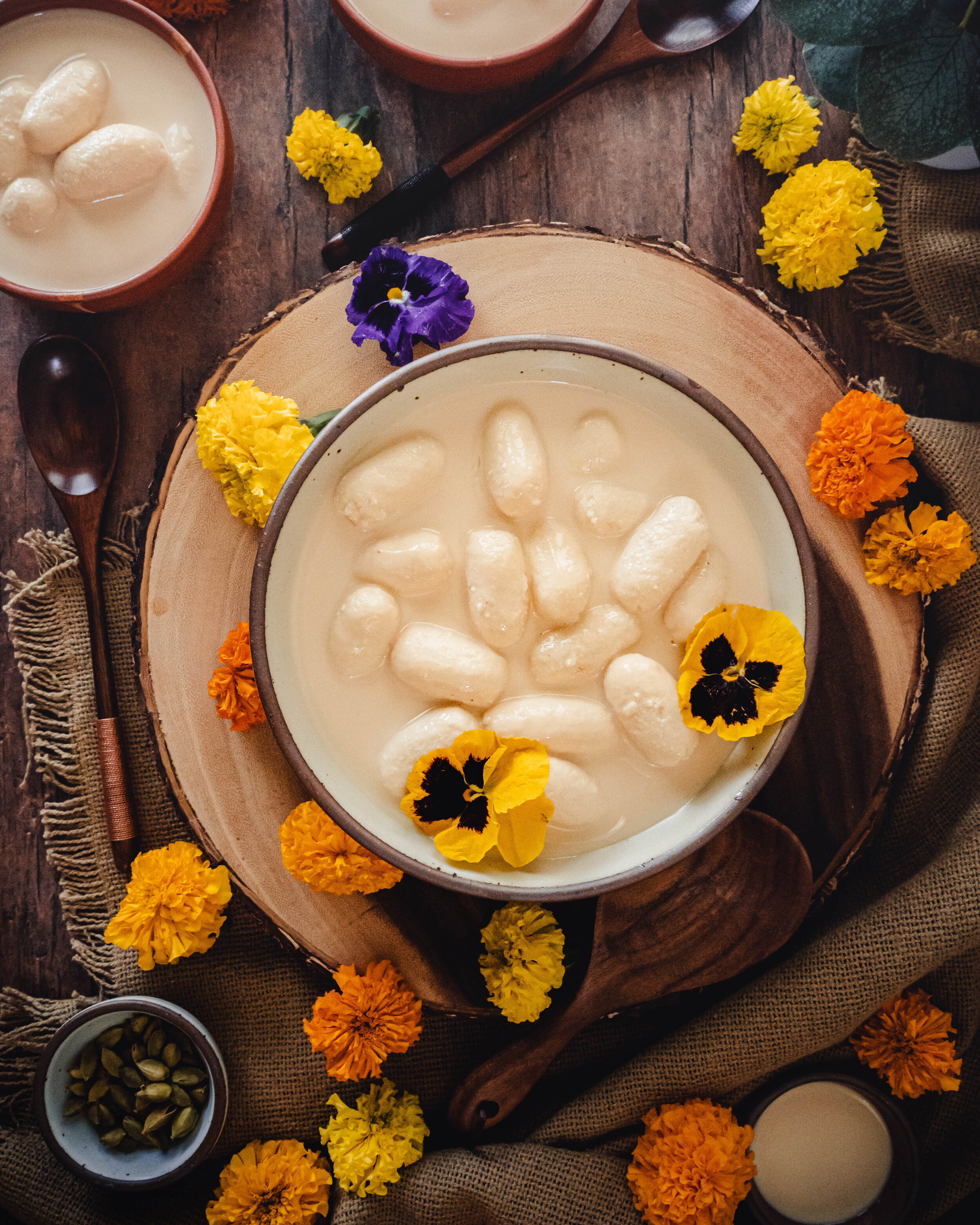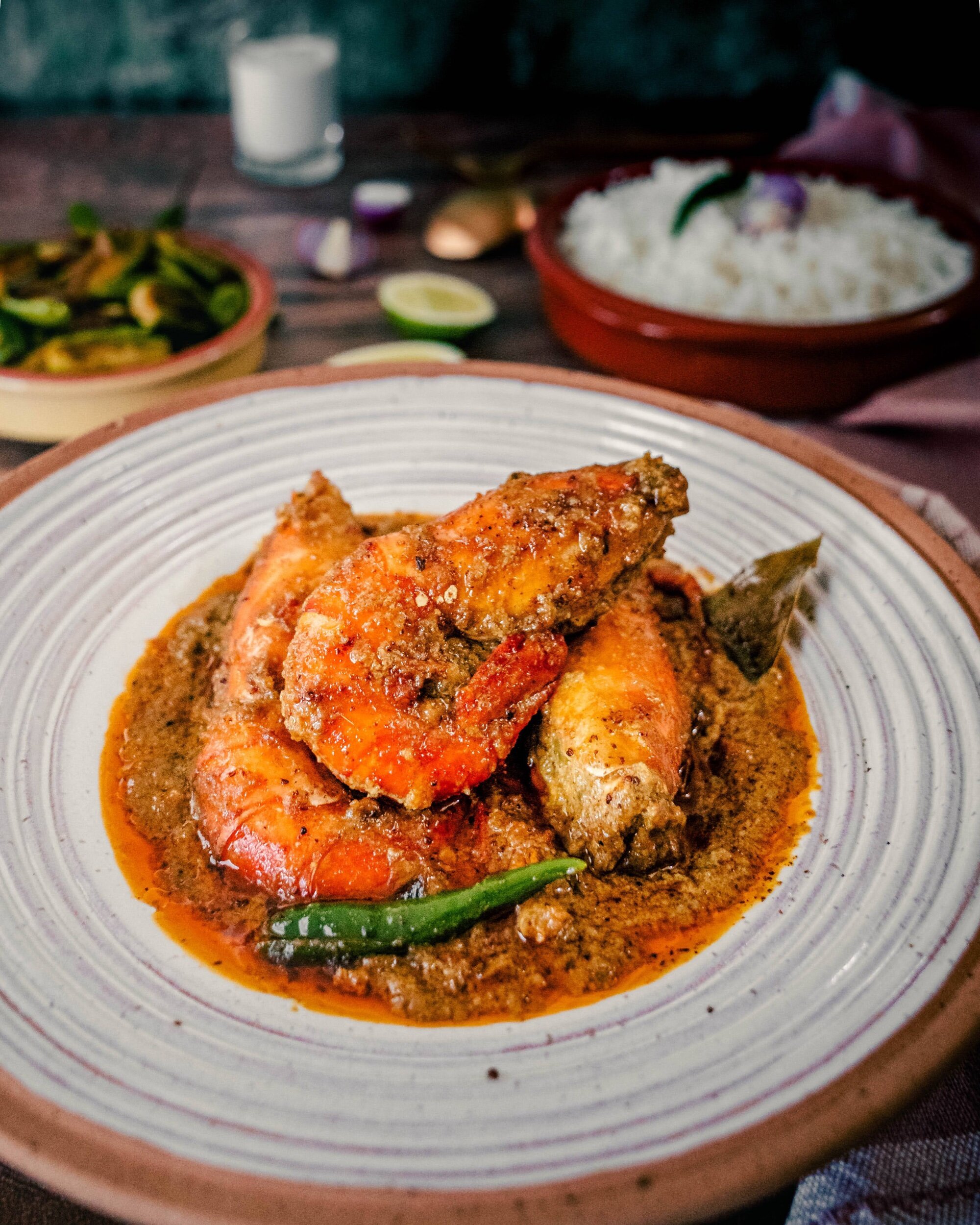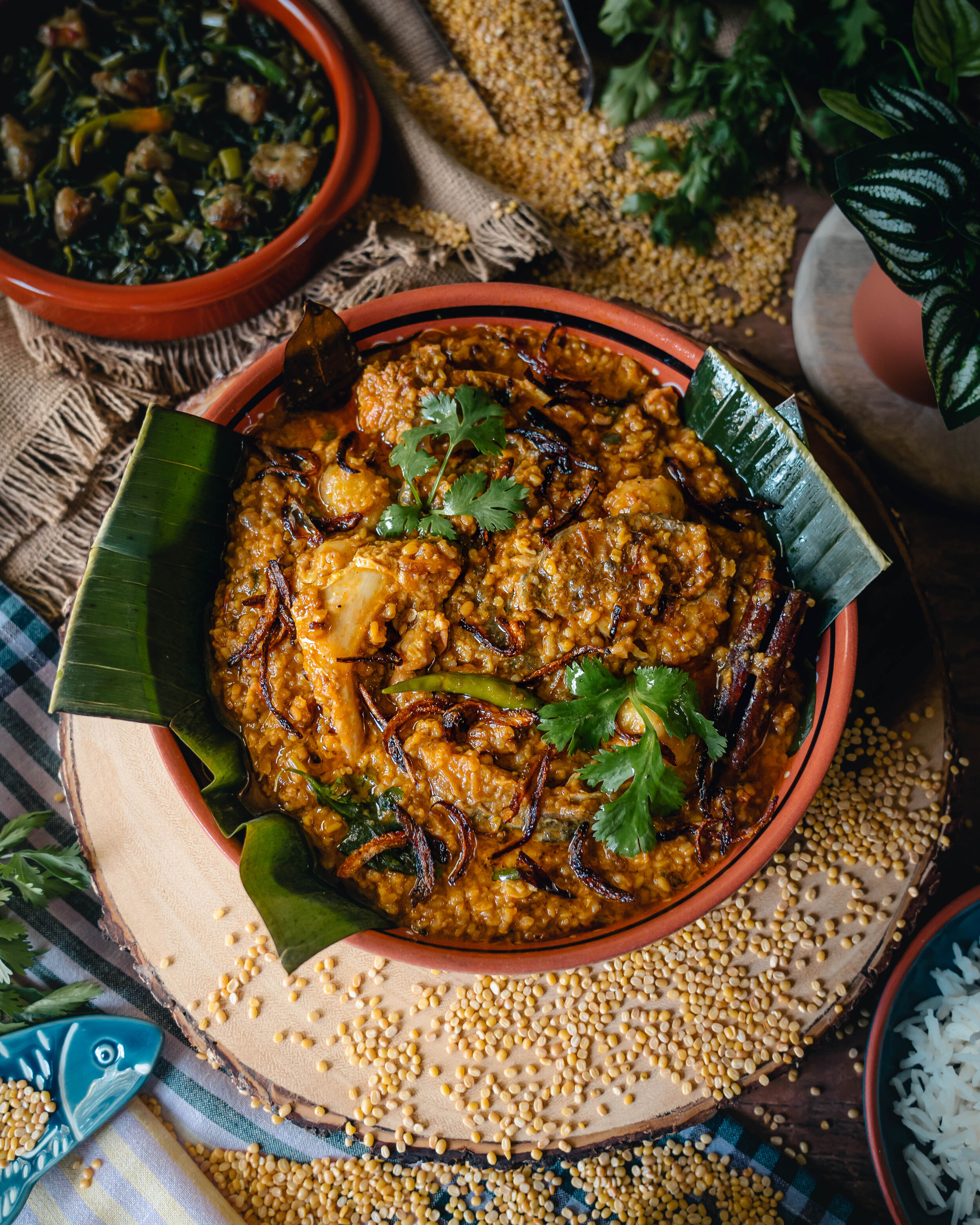Roshmalai

This is the last feature for our Bangladesh: Return to our Roots series. We are showcasing one of the oldest and revered desserts in Bengali cuisine — Roshmalai. In the Indian subcontinent, its called “rasmalai” but the real name is in fact roshmalai because it is entirely a Bengali creation, believed to have originated in the princely state Tripura, which is now modern day Comilla, Bangladesh. Once upon a time it was known as “kheerbhog” but nowadays it goes by a more common name we are all familiar with which is roshmalai in Bengal and rasmalai in India and Pakistan.
In essence, it is chhana (ricotta cheese balls) soaked in rosh (simple syrup) and then malai (sweet clotted cream). As for taste, it is a melt in the mouth delicacy, slightly like a combination of crème caramel and cheesecake without a crust. You think you like cheesecake? Wait till you have a bowl of roshmalai. You are in for a treat my friend!
On A Personal Note,
I am a stickler for the perfect bowl of roshmalai. Not only is it my one and only favorite Bangladeshi mishti but both my parents ancestral homes also happen to be from two different localities that make the best roshmalais in all of Bangladesh —Roshmalai from Comilla and Roshmonjuri from Rangpur.
Comilla is a district in Eastern Bangladesh where my father’s ancestral home is located. Every visit to-and-from my dadar bari (paternal grandparents home) involved a mandatory stop at the one and only famed roshmalai shop — Matri Bhandar. On any given visit, we would bring back at least 8-10 kg of just roshmalai alone for our friends and family. Roshmalai is even proclaimed as the king of all desserts hailing from Comilla and for any natives of this region, it is a matter of pride. Ask any Bangladeshi where the best roshmalai is from and they will tell you without a doubt — Matri Bhandar in Manoharpur, Comilla.
Then there is the famous “roshmonjuri”, another variation hailing from Gaibandha, Rangpur District in North Bengal. Rangpur also happens to be where my mother’s ancestral home is located. Every visit to my nanar bari (maternal grandparents home) required a pit stop at Gaibandha to pick up delicate earthenwares of roshmonjuri. It’s no surprise my dad loves roshmalai while my mom loves roshmonjuri, because that’s what they grew up eating. But I am the lucky girl who grew up eating both and there is so much childhood nostalgia attached to both desserts for me.
History of Roshmalai
At the beginning of the 19th century, different types of milk based sweets and desserts were being concocted by Bengali Hindu families for special occasions and events. The precursor dish to roshmalai was a roshogolla — ball-shaped dumplings made of chhana, about the size of a golf ball, soaked in sweet cream made by condensing pure milk. There wasn’t a particular name for it in the beginning, few called it Malai Roshogolla but the name never caught on. As this dessert started to gain popularity, it was officially introduced as “Kheerbhog” by the Ghosh community of Tripura, a princely state during British rule in India, which is now the modern day Comilla in Bangladesh.
Overtime, the size of the chhana dumplings became smaller and smaller so it can better submerge and soak in the sweet cream. No one knows exactly how or why kheerbhog was renamed to roshmalai but one of the running theory is that when Bengal was divided in half to West Bengal and East Pakistan, this dessert was renamed as “roshmalai” or “ras malai” for the non-Bengali people. The words ras malai in Hindi/ Urdu etymologically were taken from the Bangla word roshmalai — ras (in Hindi/ Urdu) come from the word rosh in Bangla, which means juice, and the word malai in Bangla means cream. Eventually the new name caught on and kheerbhog was left behind in history, for the textbooks and nerds like me.
Roshmalai vs Roshmonjuri
Manoharpur, Comilla District | Roshmalai
The dessert shop "Matri Bhandar" in Comilla district in Bangladesh was the first to proliferate and monetize the sale of this dessert. Brothers Khanindra Sen and Manindra Sen started the Matri Bhandar brand in 1920 and the family have been producing roshmalai ever since. Last I heard, the process to get Geographic Indication (GI) registration for Comilla’s Roshmalai is underway. If anyone is curious, currently Bangladesh has four GI registered products — Muslin, Jamdani, Hilsa fish, and the Himsagar mango.
Gaibandha, Rangpur District | Roshmonjuri
While not as famous as the Roshmalai throughout Bangladesh, Roshmonjuri is a sister dish and possibly a derivative of the erstwhile Kheerbhog. It can be found only in Gaibandha and said to have been introduced in 1948 by Romesh Ghosh and his family who own the dessert shop called "Gaibandha Mishtanno Bhandar”.
What’s the difference between the two?
Honestly, very little. To someone trying roshmalai and roshmonjuri for the first time, it may even seem like they are identical. But they do have a few small differences. For example, the chhnana or ricotta balls in roshmalai is always oval shaped while in roshmonjuri they are tiny round balls. Roshmonjuri is strictly made with full fat milk, sugar and just a little dust of flour. Meanwhile, roshmalai can also include cardamom powder, condensed milk, and a bit of cornstarch to thicken the malai.
Recipe — Roshmalai
Serves: 8-10
You might think this is the most straightforward of all Bengali mishti (desserts), it only requires two main ingredients: milk in its various forms and good ol’ sugar. Simple as it may look, it takes a lot of dedication and understanding of ingredients to perfect roshmalai. Even making the most minor mistake or choosing the wrong ingredient can make it go south. The chhana aka the ricotta cheese balls have to be pillowy soft and oval shaped, while the malai, the sweet clotted cream must be smooth, silky and spotless with a precise caramel cream color. Finally, the sweetness has to be just the right amount, absolutely not cloying but definitely not bland!
Pro Tip — be prepared to spend a lot of time working on this dessert. On average, it takes me about 5-7 hours. Making the perfect chhana ovals take time — getting the right oval shape while making sure they don’t crack. Making the malai takes a lot of patience — standing by the stove and constantly stirring the pot in order to get the proper caramel color and creamy consistency.
But don’t be deterred by this because the end result is really truly worth all that hard work. I am preparing you for success by reminding you to allocate time, and practice patience while making this. The best part is, you can make it few days ahead if you are planning on serving it for a special occasion. Because so much love and dedication goes into this dessert, when you taste it you will know right away why roshmalai is the king of all desserts in Bangladesh!
Making the Chhana | Ricotta Cheese Balls
Whole Milk - 1 litre
Full-Fat Yogurt - 1 cup
Ice Water
In a large dutch oven over high heat, bring milk to a boil. Once the milk starts bubbling away, add yogurt. As soon as the milk curdles, pour ice water to stop the cooking process. Wash the curds twice and let it strain in a cheese cloth for 30 minutes.
Tip: Try not to strain it for any longer than half an hour, the cheese curds should retain some moisture which will help in forming the chhana balls.
Take the curds out of the cheese cloth. In a mixing bowl knead gently, about 5 minutes. Make small oval shaped balls.
Tip: If the balls crack or don't form smooth balls, wet your fingers with a little bit of water. The cheese balls will crack when there isn’t enough moisture. Also it helps to put a damp towel over the cheese balls so they don’t dry out as you are making the rest.
Making the Rosh | Simple Syrup
Water - 6 cups
Sugar - 2 cups
In a separate dutch oven. bring the water to a boil, then add sugar. Don’t let it turn to a thick syrup. Just let the sugar dissolve.
Add the cheese balls, cover the lid and boil in high heat for 5 minutes. Then turn down to a medium-high heat, keep the lid covered. After 15 minutes, turn off the heat and let the cheese balls soak in the syrup for an hour.
Making the Malai | Sweet Clotted Cream
Whole Milk - 2.5 litre
In a really large dutch oven, over medium-low heat, gently reduce the milk for 1.5 hours. Stir every now and then to make sure it's not getting scorched on the bottom of the pan. As it cooks, skim and discard the skin that forms on the top of the milk.
Tip: In Bengali we call the skin shor, it’s really yummy on it’s own or you can spread it on top of warm buttered toast or with a scone. Yes, it's a delicacy and consumed in many cuisines around the world.
Cardamom Pods - 2
Sweetened Condensed Milk - 1/4 cup
Sugar - 1/4 cup
Simmer the milk until it's reduced down to roughly 1 ½ cup. Add the cardamom pods, condensed milk, and sugar. Continue to simmer until it turns to a creamy color (like the picture) and a thicker consistency. Once the malai is to your liking, pass it through a sieve and remove any skin.
Tip #1: — I am not a fan of overly sweet desserts, hence the mixture of sweetened condensed milk and sugar. If you prefer it sweet, you may omit the sweetened condensed milk and add 1/2 cup of sugar altogether.
Tip #2 —- Some people don’t like to strain the malai and they like clumps of milk skin floating. I like my malai to be smooth and I like straining the shor aka milk skin for me to nom as a side snack/treat, after all that hard work!
Bringing It All Together
Bring the reduced milk back to a clean dutch oven and bring it to a boil.
Remove the cheese balls from the syrup, making sure they have cooled and add them all at once to the boiling reduced milk. Cover the lid and let it cook for exactly 2 minutes. Turn off the heat and remove the dutch oven from the heat.
You might be tempted to eat it hot and you can! If you prefer it cold, let the roshmalai cool down and then rest overnight in the fridge.
That’s it. Few ingredients, a lot of love and patience and you have one of the best desserts in the world. Enjoy!
If you do recreate our recipe, be sure to
TAG & FOLLOW @TheSpiceOdyssey
Stay up to date with us on on Instagram, Pinterest, Youtube and Facebook.













